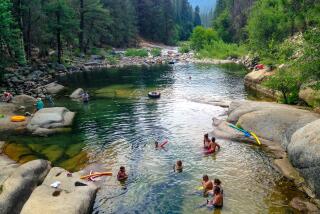Visitor spending to attend Pacific Standard Time: $111.5 million
According to a report released Thursday, the Getty’s $12-million investment in Pacific Standard Time, the sprawling collaboration among Southern California museums, has generated almost 10 times that amount in spending by tourists and local residents.
The report, prepared for the Getty by the Los Angeles County Economic Development Corporation, put total visitor spending, including lodging, food and transportation, at $111.5 million and state and local taxes generated at $19.4 million.
But in the absence of comparable data for economic activity generated by California museums before Pacific Standard Time, Getty leaders are not trumpeting the results as a huge success.
GRAPHIC: 20 most popular PST exhibits | Critic’s Notebook
Getty Trust President Jim Cuno, who is expected to speak about the report along with Mayor Antonio Villaraigosa at a press conference Thursday at the Los Angeles Central Library, sounded careful in an interview.
“It appears that the numbers are good, and it’s worth sharing those numbers with the general public,” he said. But he called any revenue generated “a byproduct” of Pacific Standard Time’s mission, “the preservation and documentation of the region’s artistic legacy and sharing it through public exhibitions.”
If cultural tourism revenue was beside the point, why did the Getty commission the study?
“As soon as this was promoted as a unique collaboration of 60 some cultural institutions attracting large numbers of visitors to Los Angeles and bringing considerable press attention to the city, people asked us: ‘What are the numbers? What is the economic impact of all that?’” Cuno said. “We hope this will become the benchmark for future studies.”
According to the report, the Getty invested $12 million directly into the initiative — about $10 million in grants to participating institutions and the rest for events and marketing. More than 60 museums and other nonprofits received grants that helped them research and stage exhibitions.
By the Getty’s estimate, about 1.8 million visitors attended Pacific Standard Time exhibitions, which ran from fall 2011 to spring 2012. The majority of visitors were local; only 13% came from other states and only 3.4% from other countries. When surveyed at participating museums, about 44% (or 742,500 visitors) said yes to the question, “Was viewing a Pacific Standard Time exhibition or event your main reason for visiting today?”
Christine Cooper, vice president of the economic and policy analysis group at the Economic Development Corporation, said that her team drew on a “wide range” of local and national data to arrive at calculations such as the $111.5 million in visitor spending.
They estimated that Pacific Standard Time created 2,490 jobs, including employees in hotels, restaurants and retail businesses as well as curators and museum personnel.
They arrived at $280.5 million as the total economic output — what “many people think of as the business revenues generated all up and down the supply chain,” she said.
GRAPHIC: 20 most popular PST exhibits | Critic’s Notebook
The challenge is putting these figures for attendance and economic activity into context. Many museums do not consistently track visitor numbers or demographics. And a recent Times survey of the 60 institutions found few reporting a significant bump in attendance due to their Pacific Standard Time exhibition.
How much of the economic activity attributed to Pacific Standard Time would have been generated in other years by the 60 Southern California arts institutions organizing their own exhibitions as usual?
Tim Hart, head of market research at the Getty, said the data needed to answer the question simply does not exist.
“We have no attendance numbers for what the 60 museums would normally bring to the region,” he said. “We hope the LAEDC report can serve as a base-line study in a way — it would be great in four or five years if we could collect this kind of data again.”
MORE:
CRITIC’S PICKS: Fall Arts Preview
TIMELINE: John Cage’s Los Angeles
More to Read
The biggest entertainment stories
Get our big stories about Hollywood, film, television, music, arts, culture and more right in your inbox as soon as they publish.
You may occasionally receive promotional content from the Los Angeles Times.






